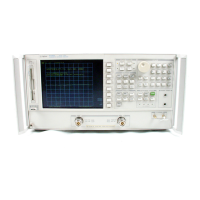12
Theory of Operation
This chapter is divided into two major sections:
n
“How the HP 8753E Works” gives a general description of the HP 8753E
network analyzer operation.
n
“A Close Look at the Analyzer’s Functional Groups” provides more detailed
operating theory for each of the analyzer’s functional groups.
How the HP 8753E Works
Network analyzers measure the reflection and transmission characteristics of
devices and networks. A network analyzer test system consists of the following:
n
source
n
signal-separation devices
n
receiver
n
display
The analyzer applies a signal that is either transmitted through the device under
test, or reflected from its input, and then compares it with the incident signal
generated by the swept RF source. The signals are then applied to a receiver for
measurement, signal processing, and display.
The HP 8753E vector network analyzer integrates a high resolution synthesized
RF source, test set, and a dual channel three-input receiver to measure and
display magnitude, phase, and group delay of transmitted and reflected power.
The HP 8753E Option 010 has the additional capability of transforming
measured data from the frequency domain to the time domain. Figure 12-1
is a simplified block diagram of the network analyzer system. A detailed
block diagram of the analyzer is located at the end of Chapter 4, “Start
Troubleshooting Here.
n
Theory of Operation
12-l

